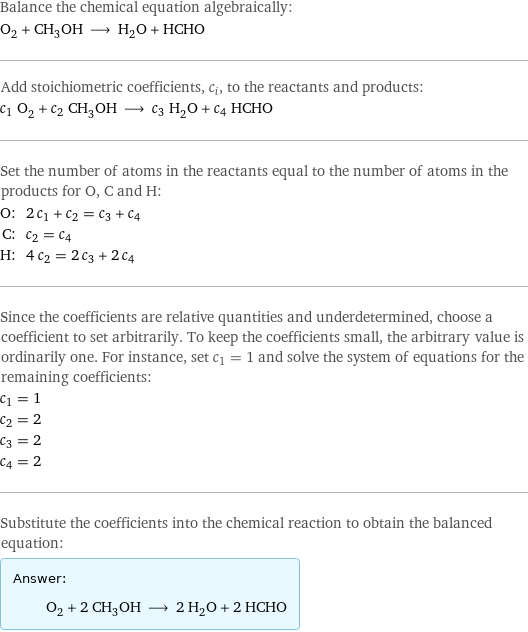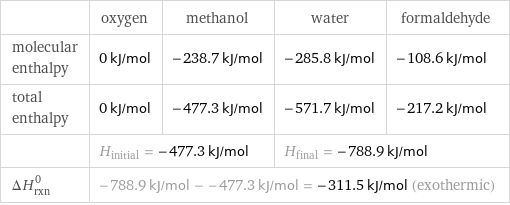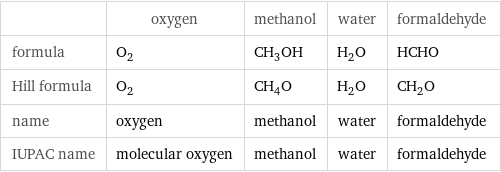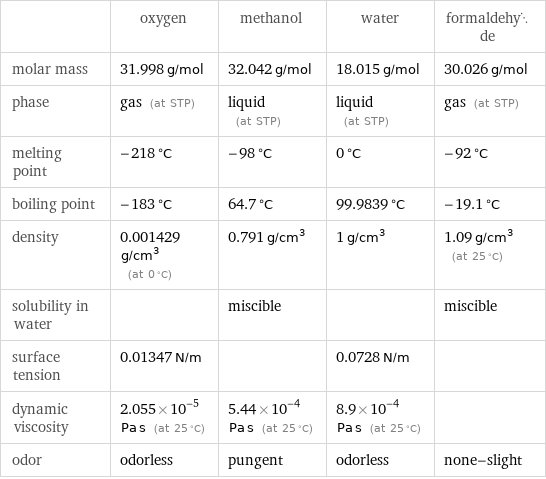Input interpretation

O_2 oxygen + CH_3OH methanol ⟶ H_2O water + HCHO formaldehyde
Balanced equation

Balance the chemical equation algebraically: O_2 + CH_3OH ⟶ H_2O + HCHO Add stoichiometric coefficients, c_i, to the reactants and products: c_1 O_2 + c_2 CH_3OH ⟶ c_3 H_2O + c_4 HCHO Set the number of atoms in the reactants equal to the number of atoms in the products for O, C and H: O: | 2 c_1 + c_2 = c_3 + c_4 C: | c_2 = c_4 H: | 4 c_2 = 2 c_3 + 2 c_4 Since the coefficients are relative quantities and underdetermined, choose a coefficient to set arbitrarily. To keep the coefficients small, the arbitrary value is ordinarily one. For instance, set c_1 = 1 and solve the system of equations for the remaining coefficients: c_1 = 1 c_2 = 2 c_3 = 2 c_4 = 2 Substitute the coefficients into the chemical reaction to obtain the balanced equation: Answer: | | O_2 + 2 CH_3OH ⟶ 2 H_2O + 2 HCHO
Structures

+ ⟶ +
Names

oxygen + methanol ⟶ water + formaldehyde
Reaction thermodynamics
Enthalpy

| oxygen | methanol | water | formaldehyde molecular enthalpy | 0 kJ/mol | -238.7 kJ/mol | -285.8 kJ/mol | -108.6 kJ/mol total enthalpy | 0 kJ/mol | -477.3 kJ/mol | -571.7 kJ/mol | -217.2 kJ/mol | H_initial = -477.3 kJ/mol | | H_final = -788.9 kJ/mol | ΔH_rxn^0 | -788.9 kJ/mol - -477.3 kJ/mol = -311.5 kJ/mol (exothermic) | | |
Gibbs free energy

| oxygen | methanol | water | formaldehyde molecular free energy | 231.7 kJ/mol | -166.3 kJ/mol | -237.1 kJ/mol | -102.5 kJ/mol total free energy | 231.7 kJ/mol | -332.5 kJ/mol | -474.2 kJ/mol | -205 kJ/mol | G_initial = -100.8 kJ/mol | | G_final = -679.2 kJ/mol | ΔG_rxn^0 | -679.2 kJ/mol - -100.8 kJ/mol = -578.4 kJ/mol (exergonic) | | |
Equilibrium constant
![Construct the equilibrium constant, K, expression for: O_2 + CH_3OH ⟶ H_2O + HCHO Plan: • Balance the chemical equation. • Determine the stoichiometric numbers. • Assemble the activity expression for each chemical species. • Use the activity expressions to build the equilibrium constant expression. Write the balanced chemical equation: O_2 + 2 CH_3OH ⟶ 2 H_2O + 2 HCHO Assign stoichiometric numbers, ν_i, using the stoichiometric coefficients, c_i, from the balanced chemical equation in the following manner: ν_i = -c_i for reactants and ν_i = c_i for products: chemical species | c_i | ν_i O_2 | 1 | -1 CH_3OH | 2 | -2 H_2O | 2 | 2 HCHO | 2 | 2 Assemble the activity expressions accounting for the state of matter and ν_i: chemical species | c_i | ν_i | activity expression O_2 | 1 | -1 | ([O2])^(-1) CH_3OH | 2 | -2 | ([CH3OH])^(-2) H_2O | 2 | 2 | ([H2O])^2 HCHO | 2 | 2 | ([HCHO])^2 The equilibrium constant symbol in the concentration basis is: K_c Mulitply the activity expressions to arrive at the K_c expression: Answer: | | K_c = ([O2])^(-1) ([CH3OH])^(-2) ([H2O])^2 ([HCHO])^2 = (([H2O])^2 ([HCHO])^2)/([O2] ([CH3OH])^2)](../image_source/5af6e56c33a77c2032ca851b3a29edcf.png)
Construct the equilibrium constant, K, expression for: O_2 + CH_3OH ⟶ H_2O + HCHO Plan: • Balance the chemical equation. • Determine the stoichiometric numbers. • Assemble the activity expression for each chemical species. • Use the activity expressions to build the equilibrium constant expression. Write the balanced chemical equation: O_2 + 2 CH_3OH ⟶ 2 H_2O + 2 HCHO Assign stoichiometric numbers, ν_i, using the stoichiometric coefficients, c_i, from the balanced chemical equation in the following manner: ν_i = -c_i for reactants and ν_i = c_i for products: chemical species | c_i | ν_i O_2 | 1 | -1 CH_3OH | 2 | -2 H_2O | 2 | 2 HCHO | 2 | 2 Assemble the activity expressions accounting for the state of matter and ν_i: chemical species | c_i | ν_i | activity expression O_2 | 1 | -1 | ([O2])^(-1) CH_3OH | 2 | -2 | ([CH3OH])^(-2) H_2O | 2 | 2 | ([H2O])^2 HCHO | 2 | 2 | ([HCHO])^2 The equilibrium constant symbol in the concentration basis is: K_c Mulitply the activity expressions to arrive at the K_c expression: Answer: | | K_c = ([O2])^(-1) ([CH3OH])^(-2) ([H2O])^2 ([HCHO])^2 = (([H2O])^2 ([HCHO])^2)/([O2] ([CH3OH])^2)
Rate of reaction
![Construct the rate of reaction expression for: O_2 + CH_3OH ⟶ H_2O + HCHO Plan: • Balance the chemical equation. • Determine the stoichiometric numbers. • Assemble the rate term for each chemical species. • Write the rate of reaction expression. Write the balanced chemical equation: O_2 + 2 CH_3OH ⟶ 2 H_2O + 2 HCHO Assign stoichiometric numbers, ν_i, using the stoichiometric coefficients, c_i, from the balanced chemical equation in the following manner: ν_i = -c_i for reactants and ν_i = c_i for products: chemical species | c_i | ν_i O_2 | 1 | -1 CH_3OH | 2 | -2 H_2O | 2 | 2 HCHO | 2 | 2 The rate term for each chemical species, B_i, is 1/ν_i(Δ[B_i])/(Δt) where [B_i] is the amount concentration and t is time: chemical species | c_i | ν_i | rate term O_2 | 1 | -1 | -(Δ[O2])/(Δt) CH_3OH | 2 | -2 | -1/2 (Δ[CH3OH])/(Δt) H_2O | 2 | 2 | 1/2 (Δ[H2O])/(Δt) HCHO | 2 | 2 | 1/2 (Δ[HCHO])/(Δt) (for infinitesimal rate of change, replace Δ with d) Set the rate terms equal to each other to arrive at the rate expression: Answer: | | rate = -(Δ[O2])/(Δt) = -1/2 (Δ[CH3OH])/(Δt) = 1/2 (Δ[H2O])/(Δt) = 1/2 (Δ[HCHO])/(Δt) (assuming constant volume and no accumulation of intermediates or side products)](../image_source/e2499a004524d491b120937b3ab90286.png)
Construct the rate of reaction expression for: O_2 + CH_3OH ⟶ H_2O + HCHO Plan: • Balance the chemical equation. • Determine the stoichiometric numbers. • Assemble the rate term for each chemical species. • Write the rate of reaction expression. Write the balanced chemical equation: O_2 + 2 CH_3OH ⟶ 2 H_2O + 2 HCHO Assign stoichiometric numbers, ν_i, using the stoichiometric coefficients, c_i, from the balanced chemical equation in the following manner: ν_i = -c_i for reactants and ν_i = c_i for products: chemical species | c_i | ν_i O_2 | 1 | -1 CH_3OH | 2 | -2 H_2O | 2 | 2 HCHO | 2 | 2 The rate term for each chemical species, B_i, is 1/ν_i(Δ[B_i])/(Δt) where [B_i] is the amount concentration and t is time: chemical species | c_i | ν_i | rate term O_2 | 1 | -1 | -(Δ[O2])/(Δt) CH_3OH | 2 | -2 | -1/2 (Δ[CH3OH])/(Δt) H_2O | 2 | 2 | 1/2 (Δ[H2O])/(Δt) HCHO | 2 | 2 | 1/2 (Δ[HCHO])/(Δt) (for infinitesimal rate of change, replace Δ with d) Set the rate terms equal to each other to arrive at the rate expression: Answer: | | rate = -(Δ[O2])/(Δt) = -1/2 (Δ[CH3OH])/(Δt) = 1/2 (Δ[H2O])/(Δt) = 1/2 (Δ[HCHO])/(Δt) (assuming constant volume and no accumulation of intermediates or side products)
Chemical names and formulas

| oxygen | methanol | water | formaldehyde formula | O_2 | CH_3OH | H_2O | HCHO Hill formula | O_2 | CH_4O | H_2O | CH_2O name | oxygen | methanol | water | formaldehyde IUPAC name | molecular oxygen | methanol | water | formaldehyde
Substance properties

| oxygen | methanol | water | formaldehyde molar mass | 31.998 g/mol | 32.042 g/mol | 18.015 g/mol | 30.026 g/mol phase | gas (at STP) | liquid (at STP) | liquid (at STP) | gas (at STP) melting point | -218 °C | -98 °C | 0 °C | -92 °C boiling point | -183 °C | 64.7 °C | 99.9839 °C | -19.1 °C density | 0.001429 g/cm^3 (at 0 °C) | 0.791 g/cm^3 | 1 g/cm^3 | 1.09 g/cm^3 (at 25 °C) solubility in water | | miscible | | miscible surface tension | 0.01347 N/m | | 0.0728 N/m | dynamic viscosity | 2.055×10^-5 Pa s (at 25 °C) | 5.44×10^-4 Pa s (at 25 °C) | 8.9×10^-4 Pa s (at 25 °C) | odor | odorless | pungent | odorless | none-slight
Units
